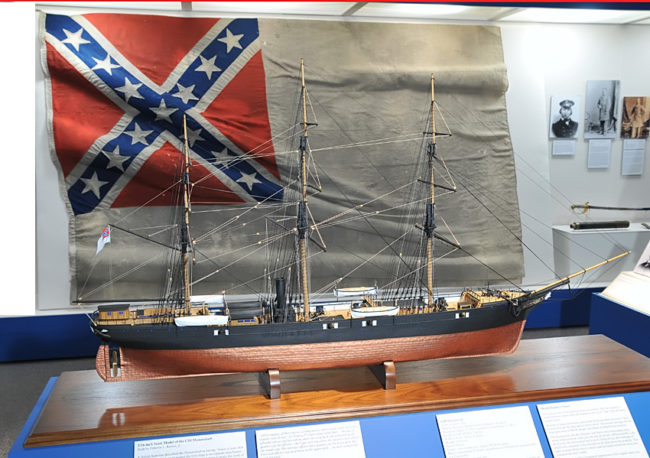
One hundred and fifty years ago, on April 9, General Robert E. Lee surrendered at Appomattox, Va. Textbooks typically say this event signaled the end of the Civil War. But a few historians make the case that the last shots of the war were actually fired from a Confederate ship off Alaska’s coast, in the Bering Sea.
She was the CSS Shenandoah, one of a handful of Confederate “commerce raiders,” commissioned to bruise the Union economy by ruining the U.S. shipping industry. The Shenandoah continued its destructive mission until the summer of 1865, nearly three months after Appomattox.
“Well, you can’t really call it ‘the last shots of the Civil War,’ because there was only one side that loosed a blank cartridge in capturing a whaling ship in the Bering Sea,” says Sam Craghead, of the American Civil War Museum in Richmond, Virginia, who has studied its strange story and its last acts of aggression near the Arctic Circle.
The Shenandoah was a 230-foot ship with both sails and a steam engine. She seized more than three dozen commercial vessels, often without firepower, though the crew burned many to the waterline and forced others to transport prisoners.
“So they destroyed the enemy’s ships and that is perfectly legitimate, under naval warfare,” Craghead says.
It sounds brutal, but Craghead isn’t one to judge Captain James Waddell harshly.
“The Shenandoah captured 1053 sailors. Not a one was harmed,” he says. “They were all sent to a friendly port on a ship that he bonded.”
By 1865, U.S. cargo ships were scarce. All the raiding and burning scared off customers and drove insurance rates sky high. So the Shenandoah chased the Yankee whaling fleet in the Pacific. In the Caroline Islands, Micronesia, Waddell burned four whaling ships he found in the harbor. But first, he took their nautical charts, revealing the Arctic whaling grounds. By then it was early April.
“So they start steaming north, heading toward the Bering Sea,” Craghead says. “That was four days after Lee surrendered at Appomattox. But if you have any idea where the Caroline Islands are — that’s out in the middle of nowhere. They might as well have been on the other side of moon, because they had no information.”
How long they remained uninformed would later be in dispute. In any case, in June the Confederate raiders were north of the Aleutian Chain, destroying one ship after another.
“All right, on the 25th, near St. Lawrence Island, they captured the whale ship Gen. Williams,” he says. “On the 26th near the same place the William C. Nigh, the Catherine and the Nimrod.”
At one point, Craghead says, the Shenandoah had 200 captives on board, and a string of a dozen small, open boats, taken from whaling ships.
“And they put those 200 men in those 12 whale boats and tied (the boats) end to end and then hooked them to the Shenandoah and pulled them along,” he says.
No need to feel too sorry for them, Craghead says, since these were hearty whalers used to traveling in these boats over long distances in icy seas.
The Shenandoah continued destroying ship after ship until June 28, 1865, when they hit the jackpot near the Bering Strait: A whaler had crashed into ice and was totaled. Other ships had gathered for an auction of its valuable whale oil and bone. The Shenandoah took them all.
“Besides the Brunswick, they burned the Congress, Covington, Favorite, Hillman, Issac Howland, Martha Second, Nassau and Waveryly,” Craghead says.
They left two whaling ships intact to carry prisoners. Craghead says one, called the James Murray, had its captain’s distraught widow and children on board.
“This captain had died during the voyage, and they preserved his body in a barrel of whiskey to take it back to New England,” Craghead says.
Finally, on August 2, 1865, after sailing south to ice-free waters, the Shenandoah came across a ship with a newspaper that said the South had surrendered, President Lincoln was dead, and the war was over. Only then did crew of the Shenandoah give up the mission.
Some historians, like U.S. authorities back in the day, accuse the men of the Shenandoah of piracy in the Bering Sea, because they must’ve known by then the war was over. Some say their prisoners told them. Capt. Wadell, though, claimed he had no proof. Yes, one ship they took in June had a newspaper that told of the surrender, but that paper also said the Confederate president had vowed to fight on. Craghead believes the captain. Regardless, Craghead says he wishes more people knew the tale.
“It’s a fascinating story! One that most people haven’t explored. We spend so much time with Grant and Lee and Jackson, that we don’t get into what happened in the Navy,” he says.
As for the captain and crew of the Shenandoah, they sailed on to England and escaped prosecution.
